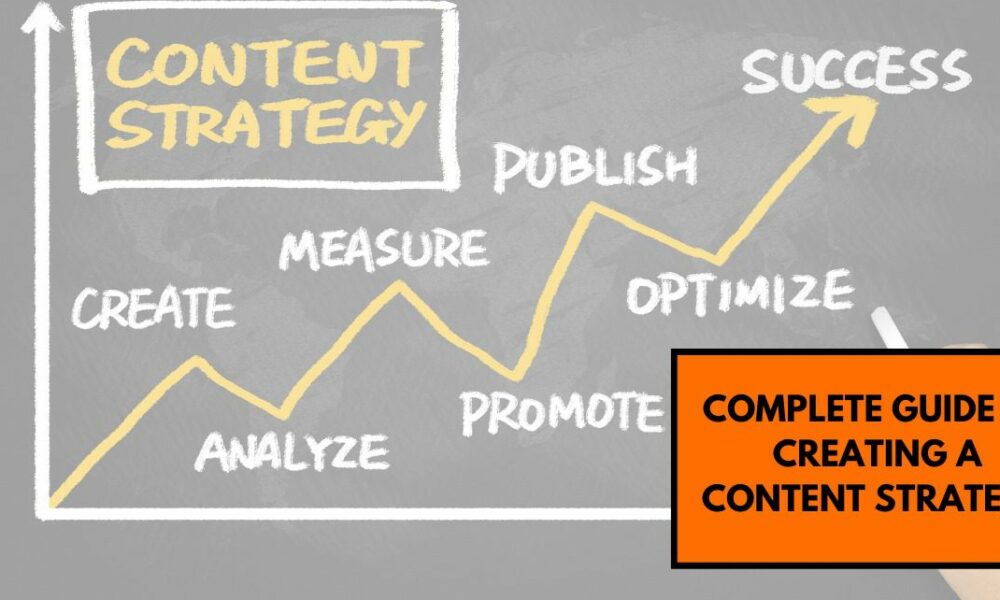Complete Guide To Creating A Content Strategy

Did you know that businesses that have a documented content strategy are more likely to achieve their marketing goals? According to a recent study by Content Marketing Institute, companies with a documented content strategy are 60% more successful in their content marketing efforts compared to those without one. With 2024 just around the corner, it’s crucial to understand what content strategy is and how to develop an effective one to engage and grow your audience in the ever-evolving digital landscape.
Understanding Content Strategy
In today’s digital landscape, having a well-defined content strategy is essential for the success of your digital marketing efforts. But what exactly is content strategy, and how can it drive results for your business in 2024?
A content strategy is a comprehensive plan that outlines how you will create, distribute, and manage your content to achieve specific business goals. It involves understanding your target audience, building a strong brand identity, and creating valuable and engaging content that resonates with your audience.
Content strategy focuses on more than just creating content; it encompasses understanding your audience’s needs and preferences, conducting competitor analysis, and optimizing your content for search engines. A well-executed content strategy can help you establish thought leadership, build brand awareness, drive organic traffic to your website, and ultimately convert leads into customers.
The key components of a content strategy include:
- Goals and Objectives: Defining the specific outcomes you want to achieve with your content, such as increasing brand awareness, generating leads, or driving sales.
- Target Audience: Identifying and understanding the demographics, interests, and pain points of your ideal customers to create content that resonates with them.
- Content Creation: Developing a plan to create valuable and engaging content in various formats, such as blog posts, videos, infographics, or podcasts.
- Content Distribution: Determining the channels and platforms where you will distribute your content, such as social media, email marketing, guest posting, or search engine optimization (SEO).
- Content Management: Establishing processes and systems to organize, update, and repurpose your content to ensure its relevance and effectiveness over time.
- Performance Measurement: Tracking key performance indicators (KPIs) to evaluate the success of your content strategy and make data-driven decisions for improvement.
By aligning your content strategy with your business goals and target audience, you can create a cohesive and impactful digital presence that resonates with your customers and drives meaningful results. Whether you’re a small business or a large enterprise, investing in a well-defined content strategy is crucial in today’s digital landscape.
So, now that you have a better understanding of what content strategy entails, it’s time to explore the next step: conducting keyword research. In the following section, we will discuss the importance of keyword research and how it can drive organic traffic to your website. Stay tuned!
Conducting Keyword Research
Keyword research is an essential component of developing a successful content strategy. By understanding the keywords your target audience is using, you can optimize your content to increase visibility and attract organic traffic. In this section, we will explore the importance of keyword research and provide practical tips on how to conduct it effectively.

The Importance of Keyword Research in Content Strategy
Keyword research enables you to uncover the specific words and phrases your audience is searching for in search engines. By incorporating these keywords into your content, you can improve your website’s visibility and relevance to the search engines. This, in turn, can drive more organic traffic to your website and increase the chances of converting visitors into loyal customers.
Without keyword research, your content may not align with your target audience’s search intent, making it difficult for them to find your website. By conducting thorough keyword research, you can gain insights into the language and terminology your audience uses, allowing you to optimize your content accordingly.
Tips for Effective Keyword Research
When conducting keyword research, it’s important to use a combination of tools and techniques to gather comprehensive data. Here are some tips to help you conduct effective keyword research:
- Start with a clear understanding of your target audience and their demographics, interests, and search behavior.
- Use keyword research tools like Google Keyword Planner, SEMrush, and Moz Keyword Explorer to identify high-volume, low-competition keywords.
- Look for long-tail keywords that are more specific and have lower competition, as they can help you attract a more targeted audience.
- Analyze your competitors’ websites and identify the keywords they are targeting successfully. This can provide valuable insights and inspiration for your own keyword strategy.
- Consider user intent when selecting keywords. Think about the purpose behind each search query and ensure your content aligns with that intent.
An Example of Keyword Research Process
Let’s say you have an e-commerce website selling sustainable fashion. To conduct keyword research for your content strategy, you can follow these steps:
- Start by researching general keywords related to sustainable fashion, such as “sustainable clothing,” “ethical fashion,” and “eco-friendly fashion.”
- Use keyword research tools to find related long-tail keywords like “vegan clothing brands,” “organic cotton clothing,” and “fair trade fashion.”
- Analyze the search volume and competition level for each keyword to prioritize the ones that are most relevant and achievable for your website.
- Include the selected keywords strategically in your website’s content, including product descriptions, blog articles, and metadata.
- Regularly monitor and analyze the performance of your chosen keywords using website analytics tools. Make adjustments to your content strategy as needed based on the data.
By following a systematic keyword research process, you can optimize your content to align with your target audience’s search behavior, increasing your chances of attracting organic traffic and achieving your content marketing goals.
Enhancing User Experience
A crucial aspect of successful content strategy is ensuring an exceptional user experience on your website. By designing and planning your website content with the user in mind, you can create a seamless and engaging experience that keeps visitors coming back for more.
Organizing and Structuring Content
When it comes to website content planning, organization is key. By structuring your content in a logical and intuitive way, you can help users navigate your site effortlessly. Consider using headers, subheaders, and bullet points to break up your content and make it easier to scan.
“Effective website content planning involves organizing information in a way that aligns with the user’s expectations and goals.”
Ensure that your website’s navigation is user-friendly and intuitive. A well-designed menu can guide users to the information they’re looking for quickly and efficiently. By providing clear and concise labels for your menu items, you can eliminate confusion and enhance user experience.
Visual Appeal
When it comes to website content, visuals play a critical role in user engagement. Incorporating high-quality images, videos, and infographics can capture the user’s attention and convey information more effectively. Additionally, using consistent branding elements, such as colors and fonts, can create a cohesive and visually appealing experience.
“Visually appealing content can significantly enhance the user experience and encourage users to spend more time on your website.”
Responsive Design
With an increasing number of users accessing websites through mobile devices, it’s essential to prioritize responsive design. Optimizing your website for mobile ensures that all users, regardless of the device they’re using, can access and enjoy your content without frustration. Responsive design improves user experience and helps to prevent high bounce rates.
Strategies for Enhancing User Experience
| Strategy | Description |
| 1. Clear Navigation | Ensure that your website’s navigation is intuitive and user-friendly, guiding visitors to the information they need. |
| 2. Visual Appeal | Incorporate engaging visuals, such as images, videos, and infographics, to capture user attention and enhance the overall experience. |
| 3. Responsive Design | Optimize your website for mobile devices to ensure a seamless experience for all users, regardless of the device they’re using. |
| 4. Consistent Branding | Use consistent branding elements, such as colors and fonts, to create a cohesive and visually appealing experience. |
By prioritizing user experience in your content strategy and implementing these strategies, you can create a website that visitors will love to explore. A seamless and engaging user experience will not only keep users coming back but also lead to higher engagement and conversions on your website.
Creating Compelling Content
When it comes to content marketing, content creation is the heart and soul of your strategy. It’s what grabs the attention of your audience and keeps them coming back for more. But how do you create content that is both high-quality and engaging? Let’s explore some techniques and strategies to help you craft captivating content.
Tell Stories That Resonate
One of the most powerful ways to capture your audience’s attention is through storytelling. By weaving relatable narratives, you can connect with your audience on a deeper level. Whether it’s sharing personal experiences, showcasing customer testimonials, or highlighting inspiring success stories, storytelling injects emotion and authenticity into your content.
Add Visual Elements
Visuals play a crucial role in content creation. Incorporating eye-catching images, videos, infographics, and other visually appealing elements enhances the overall user experience and helps convey your message effectively. Visuals break up text, making your content more digestible and engaging, while also reinforcing key points.
Format for Readability and Scannability
When it comes to online content, readability and scannability are paramount. Break up your content into smaller paragraphs and use subheadings, bulleted lists, and bolded text to enhance readability. This allows your audience to quickly scan through the content and find the information they need, improving their overall experience.
Strategies for Content Distribution and Promotion
Creating compelling content is just the first step. To ensure it reaches your target audience, you need to have effective content distribution and promotion strategies in place. Utilize social media platforms, email marketing, influencer collaborations, and guest blogging to amplify the reach of your content. By strategically sharing and promoting your content, you can increase its visibility and attract a wider audience.
“Compelling content is the key to capturing and retaining your audience’s attention. Incorporate storytelling, visuals, and formatting techniques to create engaging content that resonates with your target audience. And don’t forget to have a robust content distribution plan to ensure your content reaches the right people.”

Optimizing Content for Search Engines
Search engine optimization (SEO) plays a crucial role in ensuring your content reaches the right audience and drives organic traffic to your website. By implementing effective SEO strategies, you can improve search engine rankings and maximize the visibility of your content. In this section, we will explore key techniques and best practices for optimizing your content for search engines.
On-Page Optimization
One of the core elements of SEO strategy is on-page optimization. This involves optimizing the content, structure, and HTML coding of your webpages to improve their search engine ranking. Here are some essential on-page optimization techniques:
- Keyword Research: Conduct thorough keyword research to identify relevant and high-impact keywords for your content. Integrate these keywords naturally into your text, headings, URLs, and meta tags.
- Quality Content: Craft high-quality, informative, and engaging content that addresses the needs and interests of your target audience. Create compelling headlines, use subheadings, and incorporate relevant keywords.
- Meta Tags: Optimize your meta tags, including the meta title and meta description, to accurately describe your content and entice users in search engine results.
- URL Structure: Create clear and concise URLs that include relevant keywords, making it easier for search engines and users to understand the content of your webpages.
- Internal Linking: Build a network of internal links within your website, connecting relevant pages to improve website navigation and user experience.
Content Optimization
Content optimization focuses on enhancing the user experience and ensuring your content is valuable, relevant, and easily accessible. Consider the following strategies to optimize your content:
- Structuring and Formatting: Use appropriate headings, subheadings, and formatting techniques (such as bullet points and numbered lists) to organize your content and make it scannable for both users and search engines.
- Keyword Density: Ensure a balanced keyword density throughout your content, naturally incorporating relevant keywords without excessive repetition.
- Image Optimization: Optimize your images by using descriptive file names and alt texts. Compress images to improve page load speed.
- Mobile-Friendly Design: Create a responsive and mobile-friendly website to cater to users accessing your content on different devices.
SEO Strategy
Developing a comprehensive SEO strategy is essential for long-term success. Here are key components to consider when designing your SEO strategy:
“A well-designed SEO strategy combines technical optimization, content creation, and ongoing monitoring and adjustments.” – SEO Expert
| SEO Strategy Components | Description |
| Keyword Research | Conduct thorough keyword research to identify relevant and high-impact keywords for your content. Use keyword tools to identify search volumes and competition levels. |
| Competitor Analysis | Analyze your competitors’ SEO strategies to identify gaps and opportunities. Learn from their successes and failures to refine your own approach. |
| Link Building | Build high-quality backlinks from reputable websites to improve the authority and visibility of your content. Focus on natural link-building techniques and avoid spammy practices. |
| Performance Monitoring | Regularly monitor your website’s performance using analytics tools to identify areas for improvement and track the success of your SEO efforts. |
| Continuous Optimization | SEO is an ongoing process. Continuously optimize your content, perform periodic audits, and adapt your strategy based on data-driven insights and industry trends. |
By implementing these SEO strategies and adopting a systematic approach, you can enhance the visibility and reach of your content, improve search engine rankings, and ultimately drive more organic traffic to your website.
Understanding Audience Targeting
To create impactful content, understanding your target audience is vital. In this section, we will delve into audience targeting strategies, including defining buyer personas, conducting audience research, and tailoring content to meet their specific needs and preferences.
One of the key aspects of audience targeting is the development of buyer personas. Buyer personas are fictional representations of your ideal customers. They help you gain a deeper understanding of your target audience by identifying their demographics, interests, pain points, and motivations.
When creating buyer personas, consider factors such as age, gender, location, profession, and education level. Additionally, explore their interests, hobbies, and online behavior. By understanding what makes your audience tick, you can tailor your content to resonate with their interests and capture their attention.
Conducting audience research is another essential step in audience targeting. This involves gathering data on your existing audience, as well as potential customers, to identify common characteristics and trends. Market research surveys and focus groups can provide valuable insights into their preferences, challenges, and preferences.
“Understanding your audience is key to creating content that resonates with them. By researching their needs and preferences, you can develop content that engages and appeals to your target audience.” – Marketing Expert
Once you have gathered data and insights, it’s time to tailor your content specifically to your target audience. Create content that addresses their pain points, solves their problems, and provides value. Consider their preferred content formats, such as blog posts, videos, infographics, or podcasts, and optimize your content to meet their expectations.
Engaging your target audience requires delivering relevant and personalized content. Use data segmentation to divide your audience into smaller groups based on their characteristics and interests. By segmenting your audience, you can create content that speaks directly to each group’s unique needs, increasing engagement and conversion rates.
Example of Audience Targeting Data Segmentation
| Segment | Description | Content Approach |
| Young Professionals | Age: 25-35, Urban dwellers, working in tech | Create informative blog posts and videos about career growth, digital skills, and work-life balance |
| Parents | Age: 30-45, Married with children | Develop content on parenting tips, family-friendly activities, and product reviews |
| Outdoor Enthusiasts | Age: 18-45, Adventure seekers, nature lovers | Share inspiring stories, travel guides, and gear reviews through captivating visuals and multimedia |
By understanding your target audience and tailoring your content to their specific needs and preferences, you can significantly improve audience engagement and drive better results for your content strategy.
Leveraging Website Analytics
When it comes to developing an effective content strategy, understanding the impact of your efforts is crucial. This is where website analytics comes in. By tracking and analyzing data from your website, you gain valuable insights into how your content is performing and how it can be improved to drive better results.
Website analytics provides a comprehensive view of your digital marketing efforts. It allows you to measure key performance indicators (KPIs), such as traffic, engagement, and conversions, providing a clear understanding of your content’s impact on your bottom line.
By leveraging website analytics, you can identify the strengths and weaknesses of your content strategy, enabling you to make data-driven decisions to improve your overall digital marketing campaign. From identifying high-performing pages to understanding user behavior and preferences, website analytics empowers you to optimize your content for maximum impact.
Measuring Content Performance
With website analytics, you can measure the performance of your content at every stage of the customer journey. By tracking metrics such as page views, bounce rate, time on page, and conversion rate, you can gain insights into how users are interacting with your content and where they may be dropping off.
You can also track the performance of specific campaigns or content types to determine which initiatives are driving the most engagement and conversions. This information can help you allocate resources effectively and focus on strategies that yield the best results.
Identifying Opportunities for Improvement
Website analytics allows you to identify areas where your content strategy can be optimized. By analyzing user behavior, you can uncover patterns and trends that can inform future content creation and distribution strategies.
For example, if you notice a high bounce rate on certain landing pages, you can investigate the reasons behind it and make adjustments to improve the user experience. Similarly, if you find that certain types of content are generating more conversions, you can focus on creating more of that type of content to maximize your ROI.
Making Informed Strategic Decisions
Website analytics provides the data you need to make informed strategic decisions. By understanding how your content is performing and how it aligns with your business goals, you can make adjustments to your content strategy to ensure it remains effective.
For instance, if you find that a particular topic resonates well with your audience, you can create more content around that topic to keep them engaged. On the other hand, if you notice that a certain content format is not generating results, you can experiment with different formats to find what works best for your audience.
| Benefits of Website Analytics | How it Helps |
| Measure content performance and effectiveness | – Identifying the impact of your content on your target audience.
– Adjusting your content strategy to improve performance and engagement. – Allocating resources effectively based on data-driven insights. |
| Identify opportunities for improvement | – Uncovering patterns and trends in user behavior.
– Making adjustments to improve user experience and increase conversions. – Maximizing ROI by focusing on content types that yield the best results. |
| Make informed strategic decisions | – Creating content that resonates with your audience.
– Experimenting with different formats to optimize engagement. – Aligning your content strategy with your business goals and objectives. |
Website analytics is an invaluable tool for content strategists and digital marketers alike. By leveraging the insights it provides, you can refine your content strategy, improve user experience, and drive better results for your business.
Integrating Social Media
Social media platforms have become indispensable in the world of digital content. Leveraging social media integration effectively can significantly enhance your content strategy, increasing your reach, engagement, and website traffic.
When integrating social media into your content strategy, it’s crucial to consider your target audience and the platforms they actively engage with. This will allow you to tailor your content to their preferences and maximize your impact.
Choosing the Right Social Media Platforms
Different social media platforms cater to various types of content and demographics. Conduct research to identify the platforms that align best with your target audience’s interests and behaviors. By focusing on these platforms, you can better engage with your audience and optimize your content for maximum visibility.
For example, if your target audience consists primarily of professionals and B2B connections, platforms like LinkedIn may offer the best opportunity for engagement. On the other hand, if you have visually-oriented content, platforms like Instagram and Pinterest may be more effective for showcasing your digital assets.
Creating Engaging Social Media Content
Creating compelling content for social media requires careful consideration of the platform’s characteristics and audience preferences. Keep these tips in mind:
- Develop visually appealing content: Images, videos, and infographics are highly shareable and can help increase engagement on social media.
- Write concise and captivating captions: Craft captions that grab attention and encourage users to interact with your content.
- Encourage user-generated content: User-generated content not only fosters engagement but also builds brand loyalty and trust.
Driving Traffic and Engagement
Integrating social media effectively can drive traffic to your website and boost engagement with your content. Here are some strategies to consider:
- Share links to your website: Include direct links to relevant blog posts, landing pages, or product pages to drive traffic back to your website.
- Engage with your audience: Respond to comments, messages, and mentions to foster authentic relationships with your followers.
- Collaborate with influencers: Partnering with influencers in your industry can expand your reach and expose your content to new audiences.
By integrating social media into your content strategy, you can amplify your efforts and build a strong online presence. Continuously analyze the performance of your social media content using analytics tools to refine your strategy and achieve optimal results.
Measuring and Refining Your Strategy
Regularly measuring and refining your content strategy is essential for its success. By evaluating the effectiveness of your approach, you can make informed decisions to continuously improve and adapt your content planning.
The Importance of Key Performance Indicators (KPIs)
To gauge the performance of your content strategy, it’s crucial to identify and track key performance indicators (KPIs). These indicators provide measurable insights into how well your strategic content is meeting your goals. Some commonly tracked KPIs include:
- Website traffic: Measure the number of visitors your content attracts and their engagement levels.
- Conversion rate: Evaluate the percentage of visitors who take a desired action, such as making a purchase or signing up for a newsletter.
- Social media engagement: Monitor the interactions and reach of your content on various social media platforms.
- SEO ranking: Assess your content’s visibility and position in search engine results.
By regularly analyzing these KPIs, you can identify areas where your content strategy is successful and areas that require improvement.
Conducting Content Audits
To refine your content strategy, conducting regular content audits is key. A content audit involves assessing the quality, relevance, and performance of your existing content. This process helps you identify gaps, outdated material, or underperforming assets that may need to be updated, repurposed, or removed.
During a content audit, consider aspects such as:
- Content accuracy and freshness
- Relevance to your target audience
- Overall engagement metrics
- SEO optimization
By reviewing and optimizing your existing content, you can enhance its impact and better align it with your strategic goals.
Implementing Iterative Improvements
A successful content strategy requires continuous improvement and adaptation. As you measure the performance of your content and conduct audits, you’ll uncover insights and opportunities for enhancement.
“Effective content planning involves taking a data-driven approach and iterating based on insights gained through analysis.” – Content Marketing Institute
Based on these insights, you can implement iterative improvements to your strategic content. This may involve updating existing content, experimenting with new formats or distribution channels, or refining your targeting and messaging. Through iterative improvements, you can optimize your content strategy for maximum impact.
Summary of Measuring and Refining Your Strategy
Regularly measuring and refining your content strategy is crucial to ensure its success. By tracking key performance indicators (KPIs), conducting content audits, and implementing iterative improvements, you can optimize your strategic content to better align with your goals and continue engaging your target audience effectively.
Conclusion
Congratulations! You’ve now gained valuable insights into the world of content strategy and its significance in 2024. Developing and implementing an effective content strategy is crucial for engaging your audience, driving traffic, and achieving your digital marketing goals.
Throughout this article, we’ve emphasized the importance of ongoing content management in sustaining your strategy’s success. By consistently evaluating and refining your content approach, you can ensure that it remains aligned with your target audience’s needs and preferences.
Furthermore, staying adaptable is essential in the ever-evolving digital landscape. By keeping a finger on the pulse of emerging trends and consumer behaviors, you can proactively adjust your content strategy to maintain relevance and capitalize on new opportunities.
Remember, content management and strategy go hand in hand. With a well-defined strategy and effective management, you can create and deliver compelling content that resonates with your audience, boosts engagement, and drives your business forward.





